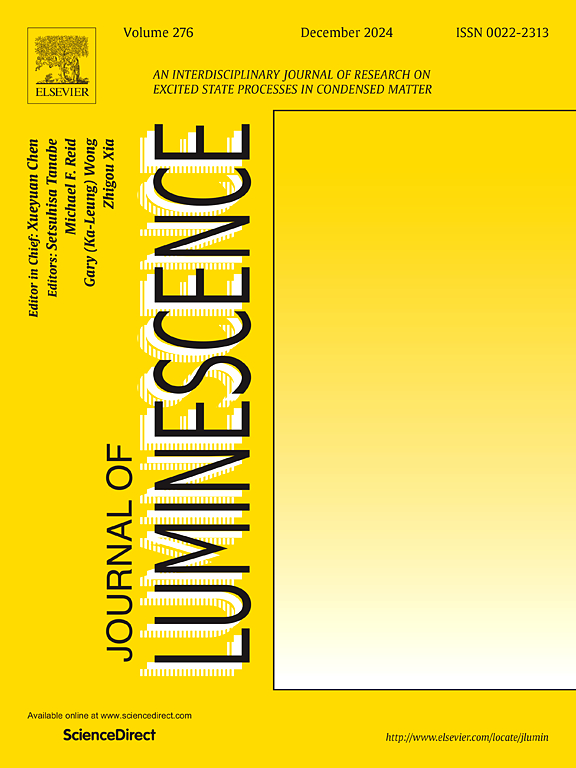用于激光驱动白光源的高显色比和热稳定Ce: YLuAG荧光粉陶瓷的锰硅共掺杂策略
IF 3.6
3区 物理与天体物理
Q2 OPTICS
引用次数: 0
摘要
单结构Ce: YAG荧光粉陶瓷(PCs)的显色指数(CRI)较低,由于缺乏红色成分,极大地限制了其在白色激光驱动(LD)照明中的实际应用。提高CRI的传统方法往往以牺牲热稳定性为代价,这对广泛采用构成了挑战。为了解决这一问题,我们提出了一种多组分共掺杂策略,将Lu3+和Mn2+/Si4+掺入Ce: YAG pc中。Lu3+的掺入稳定了晶格,保持了Ce3+和Mn2+之间的空间分离,减少了Ce3+-Mn2+的能量转移,从而抑制了非辐射跃迁,保证了优异的热稳定性。此外,Mn2+-Si4+共掺杂通过电荷补偿实现了高浓度掺入,有效地维持了强红色发射,提高了CRI。优化后的Mn10样品表现出优异的热稳定性,在423 K时保持了83.2%的发射强度。此外,Ce,Mn-Si:YLuAG的CRI从57.5提高到84.5,与Ce:YLuAG相比,在大功率LED激励下提高了47%。这些结果表明,Ce, Mn-Si: YLuAG PC具有优异的显色指数和热稳定性,是一种非常有前途的高功率白光led和ld颜色转换器。关键词:Ce: YAG荧光粉陶瓷;Ce3 + -Mn2 +共掺;白色像;显色指数;晶体场分裂。本文章由计算机程序翻译,如有差异,请以英文原文为准。
Mn-Si Co-doping strategy for high-CRI and thermally stable Ce: YLuAG phosphor ceramics for laser-driven white light sources
The low color rendering index (CRI) of single-structured Ce: YAG phosphor ceramics (PCs) greatly limits their practical application in white laser-driven (LD) lighting due to the deficient red component. Traditional methods to enhance CRI often come at the expense of thermal stability, posing a challenge for widespread adoption. To address this issue, we proposed a multi-component co-doping strategy by incorporating Lu3+ and Mn2+/Si4+ into Ce: YAG PCs. Lu3+ incorporation stabilized the crystal lattice, maintained the spatial separation between Ce3+ and Mn2+, and reduced Ce3+-Mn2+ energy transfer, thereby suppressing nonradiative transitions and ensuring excellent thermal stability. Additionally, Mn2+-Si4+ co-doping achieved high-concentration incorporation through charge compensation, effectively sustaining strong red emission to enhance the CRI. The optimized Mn10 sample demonstrated exceptional thermal stability, retaining 83.2 % of its emission intensity at 423 K. Moreover, the CRI of Ce,Mn-Si:YLuAG increased from 57.5 to 84.5, a 47 % improvement compared with Ce:YLuAG under high-power LED excitation. These results indicated that Ce, Mn-Si: YLuAG PC, with its excellent CRI and thermal stability, is a highly promising color converter for highpower white LEDs and LDs. Keywords: Ce: YAG phosphor ceramic; Ce3+-Mn2+ codoping; white LDs; color rendering index; crystal-field splitting.
求助全文
通过发布文献求助,成功后即可免费获取论文全文。
去求助
来源期刊

Journal of Luminescence
物理-光学
CiteScore
6.70
自引率
13.90%
发文量
850
审稿时长
3.8 months
期刊介绍:
The purpose of the Journal of Luminescence is to provide a means of communication between scientists in different disciplines who share a common interest in the electronic excited states of molecular, ionic and covalent systems, whether crystalline, amorphous, or liquid.
We invite original papers and reviews on such subjects as: exciton and polariton dynamics, dynamics of localized excited states, energy and charge transport in ordered and disordered systems, radiative and non-radiative recombination, relaxation processes, vibronic interactions in electronic excited states, photochemistry in condensed systems, excited state resonance, double resonance, spin dynamics, selective excitation spectroscopy, hole burning, coherent processes in excited states, (e.g. coherent optical transients, photon echoes, transient gratings), multiphoton processes, optical bistability, photochromism, and new techniques for the study of excited states. This list is not intended to be exhaustive. Papers in the traditional areas of optical spectroscopy (absorption, MCD, luminescence, Raman scattering) are welcome. Papers on applications (phosphors, scintillators, electro- and cathodo-luminescence, radiography, bioimaging, solar energy, energy conversion, etc.) are also welcome if they present results of scientific, rather than only technological interest. However, papers containing purely theoretical results, not related to phenomena in the excited states, as well as papers using luminescence spectroscopy to perform routine analytical chemistry or biochemistry procedures, are outside the scope of the journal. Some exceptions will be possible at the discretion of the editors.
 求助内容:
求助内容: 应助结果提醒方式:
应助结果提醒方式:


